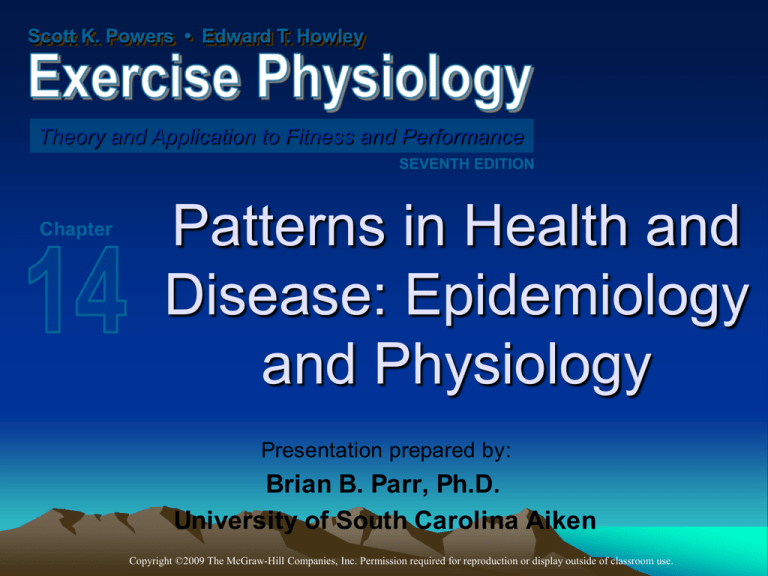
Scott K. Powers • Edward T. Howley
Theory and Application to Fitness and Performance
SEVENTH EDITION
Chapter
Patterns in Health and
Disease: Epidemiology
and Physiology
Presentation prepared by:
Brian B. Parr, Ph.D.
University of South Carolina Aiken
Copyright ©2009 The McGraw-Hill Companies, Inc. Permission required for reproduction or display outside of classroom use.
Chapter 14
Objectives
1. Define or describe the science of
epidemiology.
2. Contrast infectious with degenerative
diseases as causes of death.
3. Identify three major categories of risk
factors and examples of specific risk
factors in each.
4. Compare the epidemiologic triad with the
web of causation as models to study
infectious and degenerative disease,
Copyright ©2009 The McGraw-Hill Companies, Inc. All Rights Reserved.
Chapter 14
Objectives
5. Describe the difference between primary
and secondary risk factors for coronary
heart disease (CHD).
6. Describe the steps an epidemiologist
must follow to show that a risk factor is
causally connected to a disease.
7. Describe the hypothesis linking resistance
to insulin as a cause of hypertension.
Copyright ©2009 The McGraw-Hill Companies, Inc. All Rights Reserved.
Chapter 14
Outline
Epidemiology
Coronary Heart
Disease
Physiology
Synthesis
Physical Inactivity as a
Risk Factor
Copyright ©2009 The McGraw-Hill Companies, Inc. All Rights Reserved.
Chapter 14
Epidemiology
Epidemiology
• The study of the distribution and
determinants of health states and the use
of this information in the control of disease
• Uses of epidemiology:
– Establish the cause of disease
– Trace the natural history of disease
– Describe the health status of populations
– Evaluate an intervention
• Epidemiologic triad
– Shows connections between the environment,
agent, and host that cause disease
Copyright ©2009 The McGraw-Hill Companies, Inc. All Rights Reserved.
Chapter 14
Epidemiology
The Epidemiologic Triad
Copyright ©2009 The McGraw-Hill Companies, Inc. All Rights Reserved.
Figure 14.1
Chapter 14
Epidemiology
Disease Control
• Destroying or removing the agent at its
source
• Altering the environment to reduce
transmission of the agent
• Improving the host’s resistance to the
agent
• Altering the host’s behaviors
– Improved nutrition
– Immunization
– Exercise
Copyright ©2009 The McGraw-Hill Companies, Inc. All Rights Reserved.
Chapter 14
Epidemiology
In Summary
Epidemiology is the study of the
distribution and determinants of health
states and the use of this information in
the control of disease.
Disease control can be achieved by: (1)
destroying or removing the agent at its
source, (2) altering the environment to
reduce transmission of the agent, or
improving the host’s resistance to the
agent, and (3) altering the host’s
Copyright ©2009 The McGraw-Hill Companies, Inc. All Rights Reserved.
Chapter 14
Epidemiology
Infectious and Degenerative
Diseases
• Infectious diseases
– Tuberculosis
– Pneumonia
• Chronic (degenerative) diseases
– Cancer, heart disease, and stroke
• Responsible for 56% of all deaths in U.S. in
2004
– Difficult to establish cause of disease
• Due to genetic, environmental, and behavioral
factors
Copyright ©2009 The McGraw-Hill Companies, Inc. All Rights Reserved.
Chapter 14
Epidemiology
Web of Causation
• Difficult to establish the cause of chronic
diseases
– Atherosclerosis
• Complex involvement of factors
– Risk factors
– Genetic
• Gender, race
– Environmental
• Access to high-fat foods, places to exercise
– Behavioral
• Diet
Copyright ©2009 The McGraw-Hill Companies, Inc. All Rights Reserved.
Chapter 14
Epidemiology
Web of Causation: Titanic
Disaster
Copyright ©2009 The McGraw-Hill Companies, Inc. All Rights Reserved.
Figure 14.2
Chapter 14
Web of Causation:
Atherosclerosis
Copyright ©2009 The McGraw-Hill Companies, Inc. All Rights Reserved.
Epidemiology
Figure 14.3
Chapter 14
Epidemiology
Major Risk Factor Categories
Copyright ©2009 The McGraw-Hill Companies, Inc. All Rights Reserved.
Figure 14.4
Chapter 14
Epidemiology
Degenerative Diseases
• Result from interaction of genetics and
environment
• Inherited/biological factors
– Age, gender, race, ease of developing
disease
– Cannot be changed
• Environmental and behavioral risk factors
– Most susceptible to change
– Importance of personal responsibility
Copyright ©2009 The McGraw-Hill Companies, Inc. All Rights Reserved.
Chapter 14
A Closer Look 14.1
Epidemiology
Leading and Actual Causes of
Death
• Leading causes of
death
– Heart disease
– Cancer
– Stroke
– Chronic lung
disease
– Unintentional
injuries
– Diabetes
• Actual causes of
death
– Tobacco
– Diet and physical
inactivity
– Alcohol
consumption
– Infection
– Toxic agents
– Motor vehicles
Copyright ©2009 The McGraw-Hill Companies, Inc. All Rights Reserved.
Chapter 14
Epidemiology
In Summary
Epidemiologists show that the major
causes of death in the United States are
degenerative diseases such as heart
disease and cancer. The development
and progress of these diseases are
affected by the interaction of
environmental and behavioral risk
factors.
Copyright ©2009 The McGraw-Hill Companies, Inc. All Rights Reserved.
Chapter 14
Coronary Heart Disease
Coronary Heart Disease (CHD)
• Associated with atherosclerosis
– Thickening of the inner lining of arteries
– Contributor to heart attack and stroke death
• Diseases of the heart and blood vessels
are the leading cause of death in the U.S.
• Associated with risk factors
– Each risk factor magnifies the risk of CHD
– Eliminating a risk factor causes a reduction in
risk
Copyright ©2009 The McGraw-Hill Companies, Inc. All Rights Reserved.
Chapter 14
A Closer Look 14.2Coronary Heart Disease
Risk Factors for Coronary Heart
Disease
• Primary
– Increases risk of CHD in and of itself
• Secondary
– Increases risk of CHD if primary risk factor is
present
• Negative risk factor
– Reduces risk of CHD
– HDL-C
• Some can’t be changed
• Some can be changed
Copyright ©2009 The McGraw-Hill Companies, Inc. All Rights Reserved.
Chapter 14
A Closer Look 14.2Coronary Heart Disease
Risk Factors for Coronary Heart
Disease
• Can’t be changed
– Heredity
– Gender
– Age
– Race
• Can be changed
– Cigarette smoking
– High serum
cholesterol
– High blood
pressure
– Physical inactivity
– Blood glucose
– Obesity
– Stress
Copyright ©2009 The McGraw-Hill Companies, Inc. All Rights Reserved.
Chapter 14
Coronary Heart Disease
In Summary
Risk factors can be divided into three
categories: genetic/biological,
environmental, and behavioral.
The risk factors of smoking, high
cholesterol, and hypertension interact
to magnify the risk of CHD. Similarly,
elimination of one of them causes a
disproportionate reduction in the risk of
CHD.
Copyright ©2009 The McGraw-Hill Companies, Inc. All Rights Reserved.
Chapter 14
•
•
•
•
•
•
•
•
Determining Association
Physical Inactivity as a Risk Factor
Between Risk Factor and
Disease
Temporal Association
Plausibility
Consistency
Strength of association (relative risk)
Dose-response relationship
Reversibility
Study design
Judging the evidence
Copyright ©2009 The McGraw-Hill Companies, Inc. All Rights Reserved.
Chapter 14
Physical Inactivity as a Risk Factor
Physical Inactivity as a Risk
Factor
• Independent risk factor for CHD
• Relative risk of CHD due to inactivity is
similar to other risk factors
– Smoking
– High cholesterol
– High blood pressure
• High population attributable risk
– Percentage of population at risk
– Due to large number of inactive individuals
Copyright ©2009 The McGraw-Hill Companies, Inc. All Rights Reserved.
Chapter 14
Physical Inactivity as a Risk Factor
U.S. Population at Risk
Copyright ©2009 The McGraw-Hill Companies, Inc. All Rights Reserved.
Figure 14.5
Chapter 14
Physical Inactivity as a Risk Factor
In Summary
Physical inactivity is an independent
risk factor for CHD.
The relative risk of CHD due to
inactivity (1.9) is similar to that of
hypertension (2.1) and high cholesterol
(2.4). The fact that about 59% of the
population is inactive indicates the
enormous impact a change in physical
activity habits can have on the nation’s
risk for CHD.
Copyright ©2009 The McGraw-Hill Companies, Inc. All Rights Reserved.
Chapter 14
Physiology
Hypertension
• Often occurs with other metabolic
abnormalities
– Abdominal obesity
– Peripheral insulin resistance
– Dyslipidemia
• High triglycerides
• Metabolic syndrome
– Coexistance of these risk factors
Copyright ©2009 The McGraw-Hill Companies, Inc. All Rights Reserved.
Chapter 14
Physiology
Metabolic Syndrome
• Insulin resistance
– Reduced ability of peripheral tissues to take
up glucose
– Leads to hyperinsulinemia
• Due to higher insulin secretion by pancreas
– Also increases FFA level in the blood
• Together with abdominal obesity
• Hyperinsulinemia associated with:
– Increased SNS activity
– Increased sodium and water retention
– Increased smooth muscle proliferation in
Copyright ©2009 The McGraw-Hill Companies, Inc. All Rights Reserved.
Chapter 14
Physiology
The Insulin-Resistance and
Hypertension Hypothesis
Copyright ©2009 The McGraw-Hill Companies, Inc. All Rights Reserved.
Figure 14.6
Chapter 14
Physiology
What Causes the Metabolic
Syndrome?
• Several competing hypotheses
• Insulin resistance
– Changes in blood vessels and water
retention cause hypertension
• Hypertension
– Decrease in small blood vessels reduces
glucose and insulin delivery to muscle,
causing insulin resistance
• Increased SNS activity
– Increases blood pressure and blood glucose
Copyright ©2009 The McGraw-Hill Companies, Inc. All Rights Reserved.
Chapter 14
A Closer Look 14.3
Physiology
The Metabolic Syndrome—Is It a
Real Syndrome?
• Reasons for this question:
– Only half to two-thirds of people diagnosed
with metabolic syndrome have insulin
resistance
– Both hypertension and dyslipidemia can
exist without obesity or insulin resistance
• However:
– Diagnosis helps direct lifestyle changes
– Classification as a disease allows insurance
coverage
Copyright ©2009 The McGraw-Hill Companies, Inc. All Rights Reserved.
Chapter 14
Definition of the Metabolic
Syndrome
Physiology
• Three or more of the following risk
factors:
– Abdominal obesity
• Waist circumference >102 cm (men) and >88 cm
(women)
– Hypertriglyceridemia
• ≥150 mg/dl
– Low HDL cholesterol
• <40 mg/dl (men) and <50 mg/dl (women)
– High blood pressure
• ≥130/85 mmHg
Copyright ©2009 The McGraw-Hill Companies, Inc. All Rights Reserved.
Chapter 14
Physiology
Prevalence of the Metabolic
Syndrome
• Overall, 23.7% of the population
– 6.7% in those 20–29 years of age
– 40% in those >60 years of age
• Highest in Mexican-Americans
– 31.9% of that population
Copyright ©2009 The McGraw-Hill Companies, Inc. All Rights Reserved.
Chapter 14
A Closer Look 14.4
Physiology
Overweight and Obesity
• Prevalence in US adults
– 66.3% are overweight (BMI = 25.0–29.9
kg/m2)
– 32.2% are obese (BMI ≥30.0 kg/m2)
• Prevalence in children and adolscents
– 16% females and 18.2% males overweight
• Linked to rise in diabetes
• Recommendations for control of
overweight and obesity
– Surgeon General “Call to Action”
Copyright ©2009 The McGraw-Hill Companies, Inc. All Rights Reserved.
Chapter 14
Physiology
In Summary
The metabolic syndrome model
describes the potential causative
connections between and among
obesity, peripheral insulin resistance,
hypertension, and dyslipidemia.
The insulin resistance is located
primarily in skeletal muscle, being
greater in type II muscles with their
limited capillary supply.
Exercise can both directly and
Copyright ©2009 The McGraw-Hill Companies, Inc. All Rights Reserved.
Chapter 14
Synthesis
Healthy People 2010
• Nutrition objectives
– Achieve a healthy
body weight
– Eat <30% total
calories from fat and
<10% total calories
from saturated fat
– Eat at least five
servings of fruits and
vegetables and six
servings of grains daily
• Physical activity
objectives
– Engage in any
leisure-time activity
– Participate in
sustained activity for
at least 30 minutes
daily
– Engage in activity that
promotes
cardiovascular fitness
three or more days
Copyright ©2009 The McGraw-Hill Companies, Inc. All Rights Reserved.
Chapter 14
Study Questions
1. There is a sudden increase in the number of
birth defects in one section of a large city.
Describe what an epidemiologist might do to
determine what is causing this problem.
2. Why is a web of causation model needed to
study the causes of degenerative diseases, in
contrast to infectious diseases?
3. Physical inactivity was long considered only a
secondary risk factor. What “proof” did
investigators have to offer to convince the
Copyright ©2009 The McGraw-Hill Companies, Inc. All Rights Reserved.
Chapter 14
Study Questions
5. Draw a diagram of the hypothesized
connections between and among obesity,
insulin resistance, hypertension, and
dyslipidemia. Indicate the primary site of
insulin resistance, and explain how exercise
training might reduce the problem.
Copyright ©2009 The McGraw-Hill Companies, Inc. All Rights Reserved.






